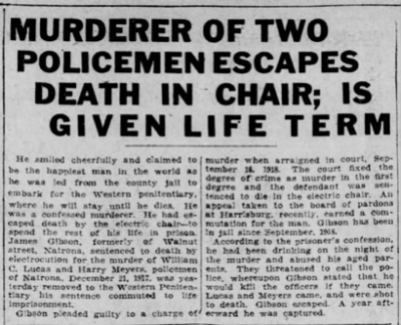On the evening of December 21, 1917, Joseph Gibson went to the Natrona police to report that his son, James, a 33-year old unemployed steelworker, was loud, drunk, and abusive, and that he wanted to have him arrested. James had reportedly told his father he would shoot any officers who came to arrest him.
When Officers William Lucas and Harry Meyers responded to the Gibson’s 93 Walnut St. home, they were shot by Gibson as he lied in wait in a shed. Gibson was armed with two double-barreled shotguns; he discharged both. The officers were shot in the face at close range. Lucas died on December 23; Meyers died on January 6, 1918. It was the first double murder of Allegheny County police officers.

Gibson, one of fourteen children, had a history of abusive behavior that included abusing his parents. On June 27, 1918, he was convicted of second-degree murder and sentenced to 16-17 years in prison for killing Officer Meyers. His father was the key prosecution witness. Gibson’s defense was that he was intoxicated.
Believing he would receive a similar disposition, on September 18, 1918, Gibson pleaded guilty to killing Officer Lucas. The judge deliberated until May 14, 1919, before determining that Gibson had committed first-degree murder. As required by statute, he was sentenced to death.

As Gibson sat in jail, labor unrest in the steel industry was moving toward the 1919 Steel Strike while unrest in the coal industry brought labor activist Fannie Sellins to Natrona to advocate on behalf of striking miners. The notorious Coal and Iron Police, which served as a publicly-created private police force for the coal industry, shot and killed her on August 26, 1919, less than a mile from Gibson’s home. As a measure of the power of industry and the impunity of its protectors, the killing was ruled justifiable.

Claiming insanity, James Gibson petitioned the Pardon Board for commutation. Troubled by the different dispositions of Gibson’s two convictions, the Pardon Board concluded that the second court erred in not considering the evidence of Gibson’s intoxication.

His death sentence was commuted to life imprisonment on March 18, 1920, and he was transferred to Western Penitentiary.
James Gibson died in prison on October 11, 1951, at age 67.
In broad outline, this case is remarkably similar to the 2009 Poplawski case, Pittsburgh’s most recent capital case. Both involved killings of multiple police officers by a defendant lying in wait after officers were called to the scene by a parent alleging abusive behavior by an adult child still living at home.

Presumably due to the notoriety of this case, the street grid of Natrona was altered to remove the section of Walnut St. on which the Gibson’s lived. That marks another similarity to the Poplawski case, whose home was razed.



One thought on “James Archer Gibson”